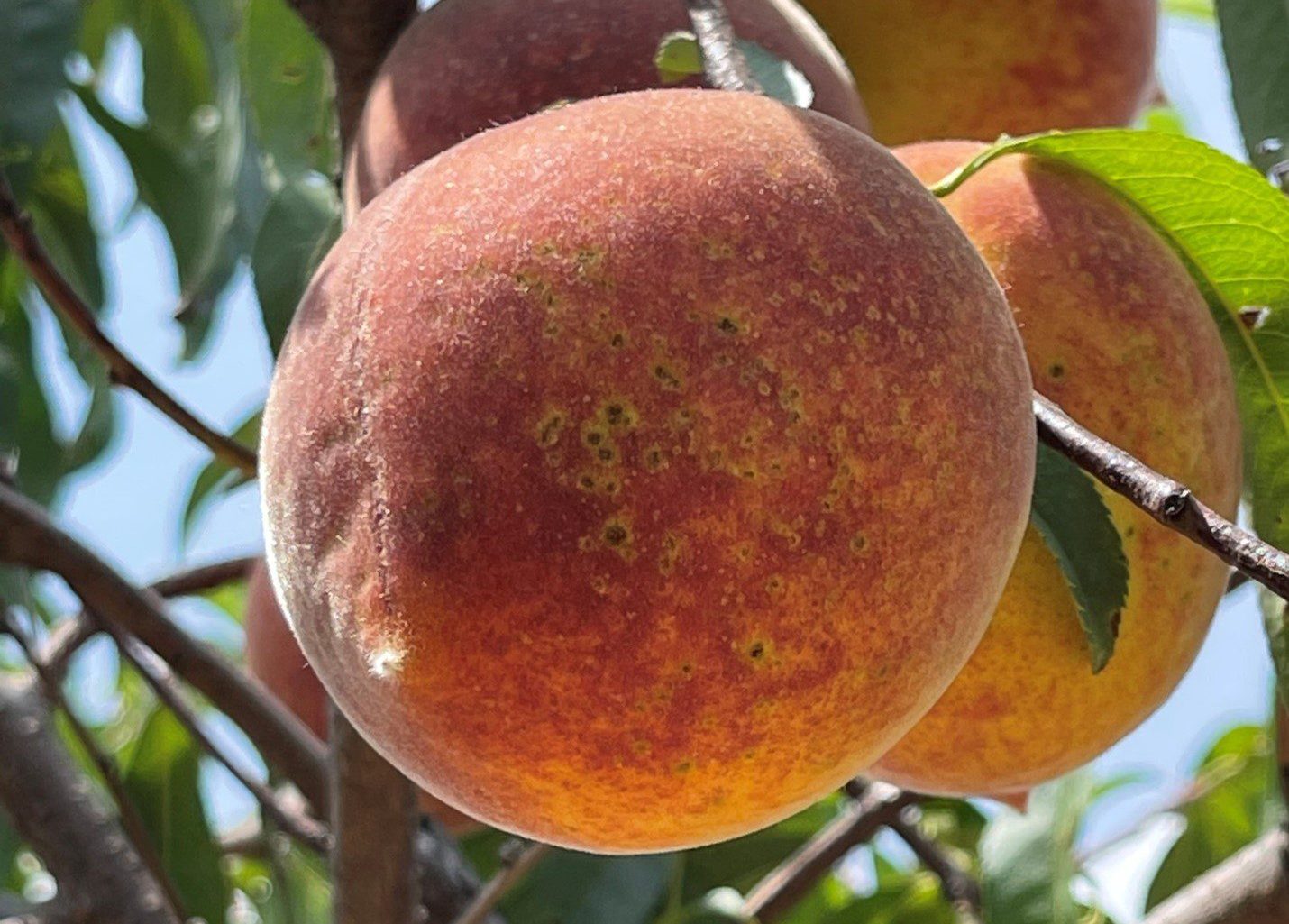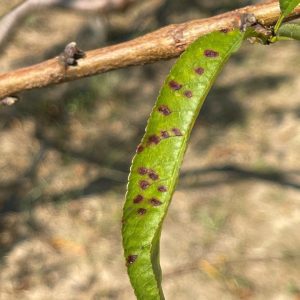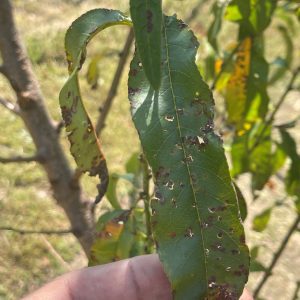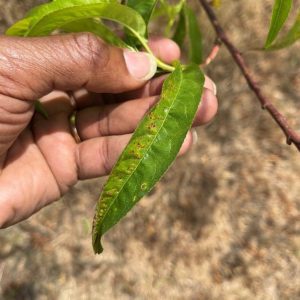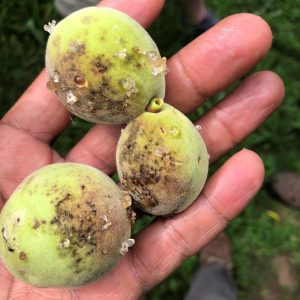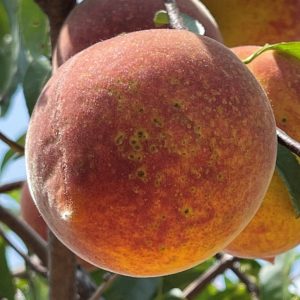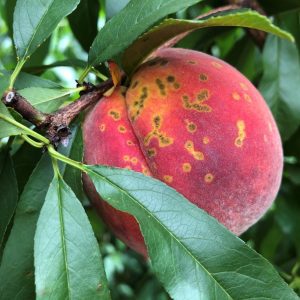Crop Production

Bacterial spot, caused by Xanthomonas arbicola pv. pruni, is considered an economically important disease of peach and other stone fruit. Bacterial spot incidence and severity vary by year based on prevailing weather conditions.
Management of this disease often requires pesticide applications effective against bacterial pathogens from the late dormant period through shuck split. Some varieties are more susceptible than others, but in the southeast, all varieties could benefit from spray applications.
Bacterial spot can affect leaves, twigs, and fruit of peaches and other stone fruits. The disease can cause slight to nearly complete defoliation of infected trees. When significant defoliation occurs early in the season, fruit size can be reduced. A reduction in marketable fruit due to bacterial spot can cut into the profits of commercial peach operations. Trees that have been severely defoliated are also more susceptible to winter injury resulting in further losses.
Symptoms
Symptoms of bacterial spot are first noticed in the leaves. Symptoms begin as small, water-soaked lesions that become larger and turn reddish brown or black over time. The growth of lesions is restricted by the leaf veins giving them an angular appearance (figure 1). The lesions occur most frequently along the midrib and at the tip of the leaves. As the disease progresses, the lesions often fall away from the leaves giving them a ragged appearance (figure 2). Leaves turn yellow and eventually fall from the tree. In trees with significant defoliation, sizing of fruit is impaired, and fruit becomes vulnerable to sunburn and other conditions that lower their marketability. Spraying copper (the main product used to manage bacterial spot) can result in leaf damage that resembles the actual disease. These spots are rounder and are not confined by veins in the leaf like those caused by bacterial spot (figure 3).
- Figure 1. Bacterial spot on a peach leaf.
- Figure 2. Advanced bacterial spot on a peach leaf. Leaf has a tattered appearance.
- Figure 3. Damage to peach leaf caused by copper sprays looks similar to bacterial spot.
In more severe cases, the fruit may become infected. Small water-soaked spots can develop on the fruit at any time during fruit development. Early infection is the most concerning because the fruit is still increasing in size. When the bacterium infects leaves or fruit, it eventually destroys the tissue. Live tissue surrounding the dead tissue will continue to grow. The result is the development of unsightly cratering or pitting on the fruit (figure 4). Infection after fruit expansion results in superficial damage rather than pitting (figure 5). Bacterial spot produces similar symptoms to peach scab, which is caused by the fungus Cladosporium carpophilum. Peach scab produces spots on the surface of the fruit that are dark, round, and surrounded by a yellow halo (figure 6). Peach scab does not cause pitting or cracking like bacterial spot, and it does not infect leaves.
- Figure 4. Early bacterial spot infection in peach fruit. Notice the pitting.
- Figure 5. Late-season infection of bacterial spot results in superficial damage.
- Figure 6. Peach scab caused by Cladosporium carpophilum produces symptoms that are similar to those of bacterial spot.
Disease Cycle
In the spring, the bacteria that cause bacterial spot will begin to ooze from cankers formed on twigs the previous summer. The bacteria are then spread by rain and insects to developing leaves and fruit of the current year’s growth. High moisture conditions favor spread of the pathogen due to frequent rains, heavy dews, or high humidity, and temperatures above 75 degrees F.
Disease Management
Commercial growers and homeowners should use sound cultural control practices to help lessen the occurrence and severity of bacterial spot. Spray programs that manage bacterial spot are preventative and not curative. Therefore, sprays or other measures must be enacted in a timely fashion.
A few chemical control options are available for use in the home orchard, so homeowners should select varieties that resist bacterial spot. Commercial growers on the other hand are tasked with producing peaches for the entire season, which includes cultivating 25 or more different early, mid-season, and late-season varieties. Table 1 lists peach varieties that are moderately to highly susceptible to bacterial spot. Few varieties are resistant to bacterial spot, so many varieties in a commercial operation will be susceptible to the disease to some degree. Seasons with exceptionally high rainfall or high humidity will likely have increased bacterial spot incidence regardless of the varieties used. More chemical options are available to commercial growers, and spray guides developed by fruit specialists with lists of registered products and application periods are especially useful. The following are strategies that can be used to manage bacterial spot.
- Timely pruning practices used by commercial growers and homeowners facilitate controlling diseases like bacterial spot. Early season pruning can help control tree vigor, and summer pruning can improve air movement and increase sunlight penetration to improve fruit ripening. Both practices can encourage faster leaf drying after a rain as well as better coverage of copper and antibiotic sprays used to control bacterial spot.
- Bacterial spot is more severe in trees grown in sandy soils and stressed trees. Trees planted in sandy areas, such as near dirt roads, can be especially susceptible as wind-blown grains of sand can cause wounds on leaves, which can be entry points for the pathogen.
- Plant bacterial spot–resistant or less susceptible varieties. Using resistant varieties is the most sustainable way to control the disease. The most resistant varieties can still benefit from spray applications because in wet years even the most resistant variety can be infected with bacterial spot.
- Fertilize trees according to recommendations. Trees that are vigorous and receive proper care are less susceptible to bacterial spot.
- Apply chemical sprays that contain copper during the dormant period, and continue to apply them during the spring and summer months to reduce the spread of the disease and the amount of overwintering inoculum for the following spring. Homeowners have fewer chemical spray options. Find a list of products in “Home Orchards: Disease and Insect Control Recommendations” (IPM-1308) on the Alabama Extension website at www.aces.edu. Always follow the manufacturer’s labeled directions and restrictions when using any pesticide.
Table 1. Peach Varieties Resistant or Susceptible to Bacterial Spot When Grown in the Southeastern United States
| Variety | Season of Ripeness1 | Resistant or Susceptible |
|---|---|---|
| Augustprince | Late | R |
| Autumnprince | Late | R |
| Blazeprince | Mid | S |
| Bounty | Late | S |
| Caro King | Mid | S |
| Carolina Belle | Late | S |
| Carored | Early | S |
| Elegant Lady | Late | S |
| Fay Elberta | Late | S |
| Flameprince | Late | S |
| Flavorcrest | Mid | S |
| GaLa | Early | S |
| Goldprince | Early | R |
| Halehaven | Early to Mid | S |
| Harvester | Mid | R |
| Juneprince | Early | R |
| Loring | Mid | R |
| O’Henry | Late | S |
| Parade | Late | S |
| Red Haven | Late | R |
| Scarletprince | Mid | S |
| Spring Flame | Mid | S |
| Summerprince | Mid | R |
| Suncrest | Mid | S |
References
- Bost, S. Plant Diseases: Bacterial spot of peach. Agri. Ext. Serv. Univ. Tenn. Bul. SP277-1.
- Chavez, D., M. Florkowska, J. Cook, and E. Little. 2015. Home garden peaches. Univ. Gz. Coop. Serv. Bul. 1063.
- Shane, B. and G. Sundin. 2011. Management of bacterial spot on peaches and nectarines. Michigan State Univ.
- Peter, K.A. 2017. Peach disease – Bacterial spot differentiation from copper injury. Penn. State Extension.
 Edgar Vinson, Assistant Extension Professor; Kassie Conner, Extension Specialist; and Edward Sikora, Extension Specialist, Professor, all in Commercial Horticulture, Auburn University
Edgar Vinson, Assistant Extension Professor; Kassie Conner, Extension Specialist; and Edward Sikora, Extension Specialist, Professor, all in Commercial Horticulture, Auburn University
New January 2023, Bacterial Spot Treatment in Peaches, ANR-2962

